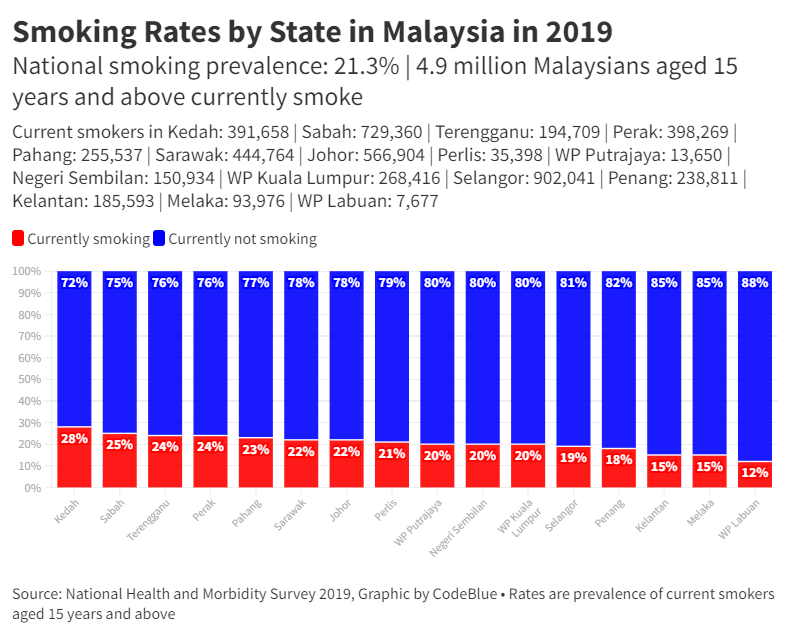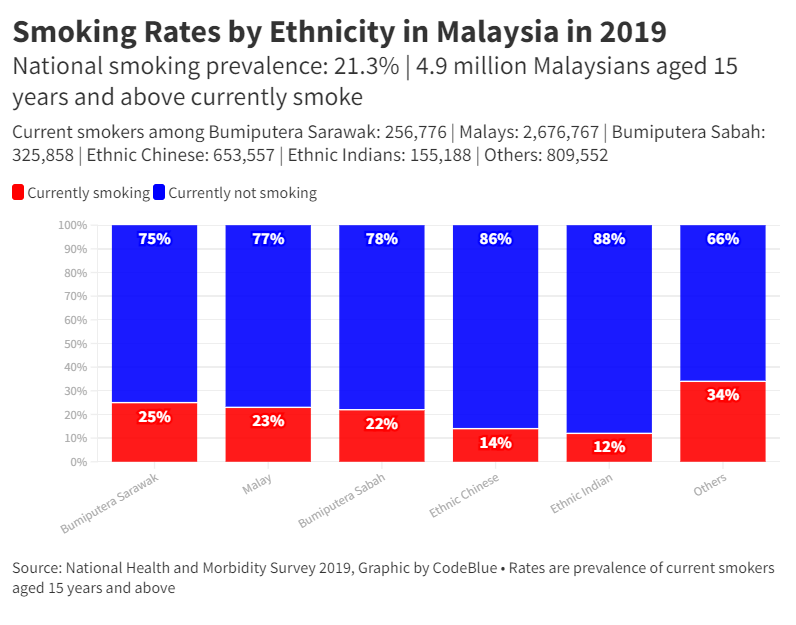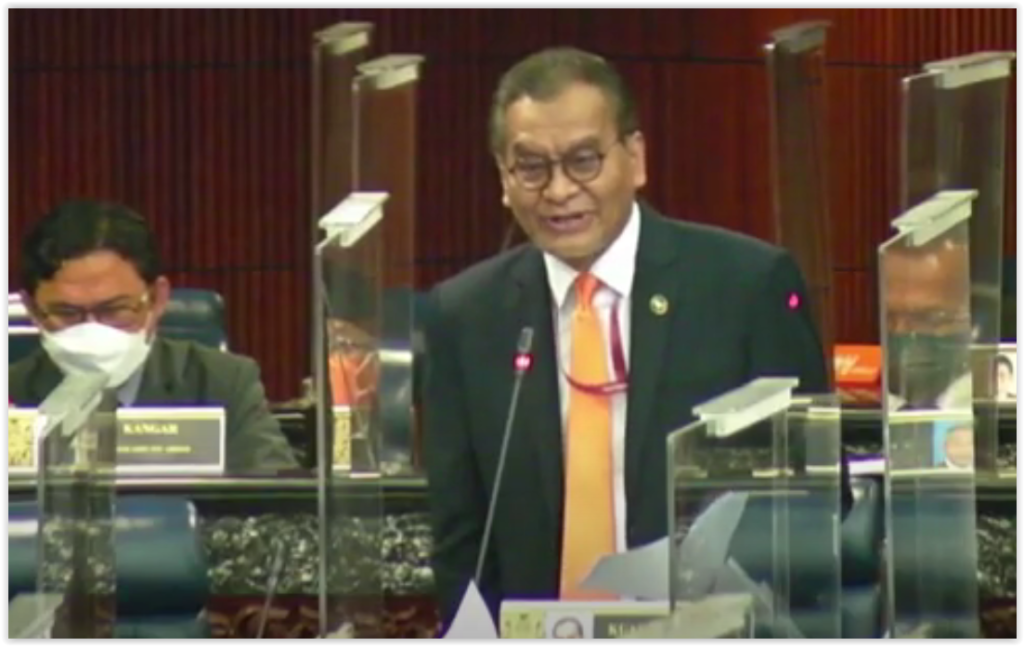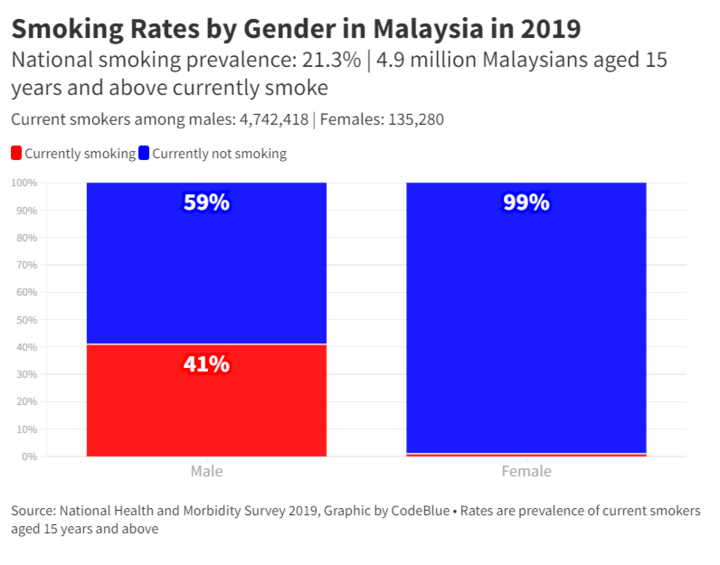KUALA LUMPUR, Jan 26 – The government sought for years to tackle smoking in Malaysia, with little success as more than one in five adults over 15 light up.
When Pakatan Harapan (PH) came into power in 2018, then-Health Minister Dzulkefly Ahmad made the bold move of banning smoking in restaurants and eateries.
Health Minister Khairy Jamaluddin from Prime Minister Ismail Sabri Yaakob’s administration is taking an even more radical step to create a smoke-free country by attempting to prohibit the sale of cigarettes to future generations, so that Malaysians in their teens now will never be able to legally buy tobacco in their lifetime.
Malaysia’s smoking rates have barely declined, dropping only by 1.5 percentage points from 22.8 per cent in 2015 to 21.3 per cent in 2019 among individuals aged 15 years and older, according to Malaysia’s 2020 report to the World Health Organization’s Framework Convention on Tobacco Control (FCTC).
The National Health and Morbidity Survey (NHMS) 2019 estimates that 4.9 million Malaysians aged 15 years and older currently smoke. Four in 10 men smoke, compared to just about 1 per cent of women, indicating that smoking is predominantly a male problem.
There are an estimated 4.7 million male smokers in the country, compared to slightly more than 135,000 smokers among women, equating to 35 men who puff for every female smoker.

Almost half, or 49 per cent, of men aged 30 to 34 currently smoke, according to Malaysia’s FCTC 2020 report. Smoking prevalence rates at 45 per cent or higher cut across all age groups among men, except for male teens aged 15 to 19, of whom 24 per cent light up.
Disturbingly, 17.4 per cent of boys and girls aged 13 to 15 currently smoke. Nearly one in 10, or 9.2 per cent, of boys and girls aged 12 and younger also smoke. The legal age for smoking in Malaysia is 18.

Kedah recorded the highest smoking rates in the country at 27.6 per cent, followed by Sabah (25.3 per cent), Terengganu (23.9 per cent), Perak (23.8 per cent), and Pahang (23.1 per cent), according to the NHMS 2019.
About a quarter of Bumiputera Sarawak currently smoke, followed by Malays (22.6 per cent), Bumiputera Sabah (21.7 per cent), ethnic Chinese (13.7 per cent), and ethnic Indians (11.5 per cent).

Based on the NHMS 2019, higher prevalence of current smoking was observed in rural areas at 25.4 per cent, compared to 20.1 per cent of Malaysians living in urban areas who currently smoke.
About a quarter of Malaysians with primary or secondary education currently smoke, compared to 13 per cent among those with tertiary education.

About 4.9 per cent of Malaysians aged 15 years and above currently use e-cigarettes or vaping products. Some 9.4 per cent of men vape or use e-cigarettes. E-cigarettes or vape are most commonly used by young people aged 20 to 24 at 14.7 per cent prevalence.
The National Strategic Plan for Tobacco Control 2015-2020 aims for a tobacco “endgame” to reduce smoking prevalence to below 15 per cent by 2025 and to below 5 per cent by 2045.
Malaysia has fallen behind targets with 21.3 per cent smoking prevalence in 2019, nearly 3 percentage points higher than the 18.5 per cent goal for that year in the strategic plan. The plan mooted a goal of 16.7 per cent smoking prevalence for 2022.
RM3 Billion Yearly To Treat Smoking-Related Diseases

Dzulkefly, citing the NHMS 2019, noted that more than 27,200 smoking-related deaths in Malaysia are reported annually, compared to the 32,000 fatalities from Covid-19 recorded in the past two years.
Smoking causes diseases like cancer, heart disease, stroke, lung diseases, diabetes, and chronic obstructive pulmonary disease, according to the United States’ Centers for Disease Control and Prevention (CDC). Smoking is also a known cause of erectile dysfunction in men.
The cost of treating major smoking-related diseases in Malaysia is estimated at RM3 billion a year, Dzulkefly noted.
The former health minister admitted that when he first imposed the no-smoking rule in restaurants, some of the then-Cabinet members were worried about public backlash from smokers.
“But both my deputy and l then, and also with solid support from the technocrats and bureaucrats in MOH, were bent on biting the bullet, so to say. Looking back, no qualms or regrets, we are more than vindicated when we witness the overwhelming support to date!” Dzulkefly told CodeBlue.
Non-communicable diseases (NCDs), he said, cause a huge disease burden. Prior to the coronavirus pandemic, MOH under Dzulkefly’s leadership was focused on the NCD crisis.
“Objectively speaking, we managed to imbibe the consciousness of public health and respect for public space, especially for those who aren’t able to stop or not as yet into our Quit-Smoking programmes in our clinics. But l dont think it has significantly affected smoking-rate reduction.”
Dzulkefly welcomed Khairy’s plans to table the new Tobacco and Smoking Control Act in the upcoming Parliament meeting to replace current tobacco product control regulations under the Food Act 1983.
Khairy previously said the proposed new law would not just contain provisions to ban smoking for the next generation, but also regulate vaping products. For Budget 2022, the government plans to tax vape and e-cigarette liquids that contain nicotine, effectively legalising these products.
Dzulkefly called for the new Tobacco and Smoking Control Act to include a commitment to reduce the national smoking rate, regulate tobacco use, ban all e-cigarettes or vape and tobacco product advertisements, and a plan for a “smoke-free generation”.
New Law Must Contain All FCTC Provisions
Dr Zarihah Mohd Zain, the former head of Ministry of Health’s (MOH) tobacco control unit and FCTC secretariat, said it was “absolutely possible” that Malaysia’s smoking rates may have increased after 2019 during the Covid-19 pandemic.
“Tobacco products were readily available during the MCO (Movement Control Order) periods and now post-MCO, it won’t be surprising if consumption has escalated. Cigarette prices are so affordable in Malaysia — the government has kept tobacco taxes static for over five years now,” she told CodeBlue.
Malaysia’s high smoking prevalence among men, she said, will subsequently lead to a “huge” burden of chronic diseases in the near future, which she said would be “catastrophic for the nation’s health services and certainly dampen national progress”.
Dr Zarihah also expressed concern about smoking and vaping among youths, pointing out that vaping could lead to tobacco smoking and dual usage of both cigarettes and vape. According to the NHMS 2019, more than 600,000 Malaysians aged 15 to 24 vape or use e-cigarettes.
Dr Zarihah praised Khairy’s plans to replicate New Zealand’s move in implementing a cohort smoking ban. Khairy has not yet stated when the age-based smoking ban will come into effect, or which cohort will be targeted.
New Zealand plans to ban the sale of tobacco to anyone born after 2008, who will never be able to buy cigarettes — ever.
Dr Zarihah said Malaysia’s proposed cohort smoking ban should not just cover cigarettes, but also vape and any form of tobacco products. Prohibiting the sale of tobacco to the 2008 cohort would mean targeting those aged 14 this year, who would be in Form One or Form Two in secondary school.
“Perhaps kids in primary schools would be much easier to handle. Hence if we target the 2012 cohorts, it’d be more doable — can achieve something by 2030.”
Besides the smoking ban, Dr Zarihah said the proposed Tobacco and Smoking Control Act should include all FCTC provisions, including plain packaging for all tobacco products or enlarged pictorial health warnings that cover at least two-thirds of the biggest display surface on the product.
Displays of tobacco products at all points of sale should also be prohibited. Dr Zarihah further suggested raising tobacco taxes at least five-fold.
Smoke-free areas should be expanded to include more public spaces. Smoking in the presence of children should be made an offence. Dr Zarihah also said all tobacco retailers must be licensed and licence fees must be high enough to deter widespread sales.
“There must be political will and strong commitment on the part of policymakers to adhere to all the provisions of the FCTC.”









